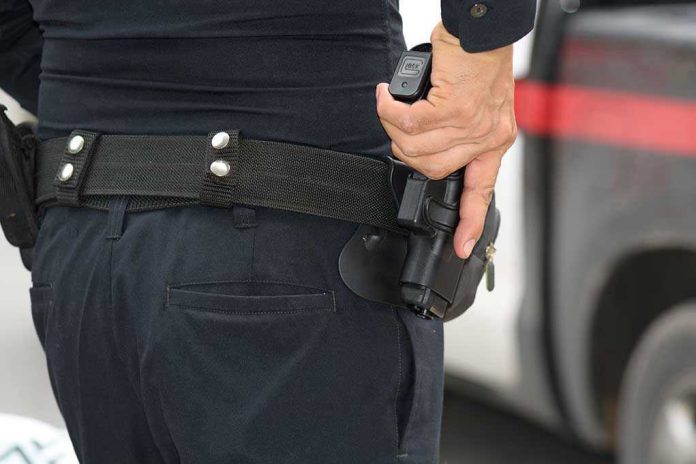
A Florida deputy mistook a gas pump nozzle for a gun, drew his weapon, and triggered a viral debate about police training, perception, and the thin line between vigilance and overreaction.
Story Highlights
- A Leon County Sheriff’s deputy drew his firearm on a man at a Tallahassee gas station after mistaking the gas nozzle in his hand for a pistol.
- Body camera footage—quickly circulated online—shows the man was filling a gas can and signaling to the store clerk, not threatening anyone.
- No one was injured, but the officer’s failure to apologize and the viral nature of the video intensified public criticism and scrutiny of law enforcement practices.
- The incident highlights ongoing concerns about misidentification, profiling, and the need for improved police training and accountability.
The Moment Everything Changed
The body camera footage begins with the deputy approaching the man at the Circle K pump. The man, holding a gas can, raises the nozzle—apparently to signal the clerk inside. The deputy, interpreting the nozzle as a firearm, draws his weapon and orders the man to show his hands. The man complies immediately, confusion evident in his voice as he explains his actions. The video, later shared widely, leaves no ambiguity: the “weapon” was a gas pump nozzle, an everyday object in a routine situation.
This was not a high-speed chase or a dark alley confrontation. It was broad daylight at a busy gas station, a setting familiar to millions. The deputy’s split-second decision—rooted in a misperception—turned a mundane errand into a potential life-or-death encounter. Such incidents are not isolated. Police have historically mistaken cellphones, wallets, and even sandwiches for guns, with tragic consequences in some cases. The Florida gas station incident, however, stands out for its absurdity and the clarity of the video evidence.
Public Reaction and Law Enforcement Response
Public reaction was swift and polarized. Social media erupted with criticism of the deputy’s judgment, with many accusing him of profiling and reckless behavior. The civilian involved, unharmed but shaken, demanded an apology that never came. The Leon County Sheriff’s Office issued a statement confirming the incident and promising a review, but as of October 2025, no disciplinary action had been announced. The lack of immediate accountability deepened public skepticism.
Meanwhile, the store clerk expressed appreciation for police vigilance but did not corroborate the officer’s perception of a threat. This split highlights a recurring tension: communities want protection, but not at the cost of innocent civilians facing drawn weapons during everyday activities. The body camera footage, now a staple of online debate, serves as Exhibit A in the court of public opinion—a digital Rorschach test for views on policing in America.
Broader Implications for Policing and Public Trust
The incident taps into a national conversation about police training, perception, and the psychology of threat assessment. Experts point out that such misidentifications are symptomatic of deeper issues: inadequate training in distinguishing threats from harmless objects, implicit bias, and a culture that prioritizes officer safety over de-escalation. The Florida case is a reminder that the stakes are not abstract—real people, going about their daily lives, can become collateral damage in a moment of misjudgment.
Short-term, the episode erodes trust between law enforcement and the communities they serve. Long-term, it may lead to calls for revised use-of-force protocols, mandatory psychological evaluations, and more robust training in situational awareness. The economic impact could include legal costs if the civilian pursues a lawsuit, while the social impact reverberates through communities already wary of police interactions.
From a conservative perspective, the incident underscores the importance of common sense and proportionality in law enforcement. While officers must be vigilant, the public rightly expects discernment—a balance between preparedness and restraint. The lack of an apology or corrective action from the deputy or his department only fuels perceptions of unaccountability, a concern that transcends political lines.
Expert Perspectives and the Path Forward
Policing analysts and scholars agree: the Florida gas station incident is a teachable moment. It illustrates the dangers of “shoot first, ask questions later” mentalities and the need for continuous, scenario-based training. Some community members still value police presence, but the consensus is clear—missteps like this cannot become the norm. The solution lies not in defunding police, but in investing in better training, transparency, and accountability.
The incident also raises questions about the role of technology and public scrutiny. Body cameras, once hailed as tools for accountability, now ensure that every misstep is captured, shared, and dissected. This transparency can be a double-edged sword: it holds officers accountable but also amplifies mistakes, sometimes overshadowing the majority of uneventful, professional police work.










